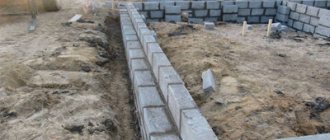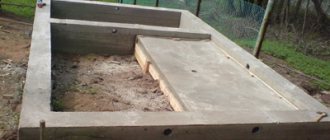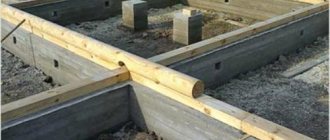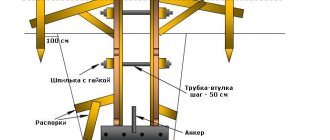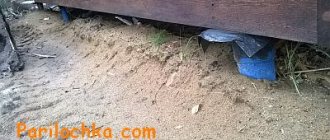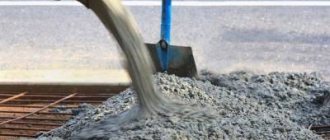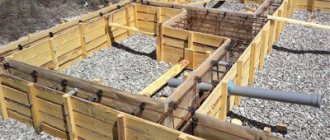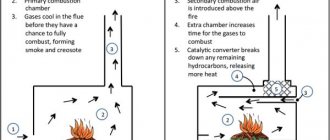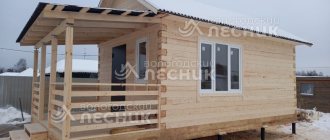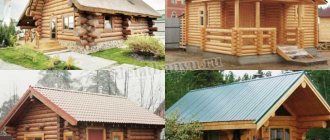Construction of a bathhouse made from logs has recently been in demand in all regions of Russia, because wood is a safe material that does not cause diseases or allergies. Some types of wood were classically used for the construction of baths (linden), as their wood has healing powers. Installing a log bathhouse with your own hands entails constructing a reliable foundation. What kind of foundation is better to provide for a bathhouse made of a wooden frame? The answer is in this article.
Selection and technology of building a foundation for a bathhouse.
A modern bathhouse is a lightweight structure made of logs or timber that can stand on any type of foundation.
When choosing a foundation, you need to take into account the characteristics of the soil on the site and economic feasibility - extremely reliable foundations made of a monolithic slab or reinforced concrete piles for a small bathhouse with an area of up to 6x6 m will simply be unnecessary. Installation of a log bathhouse on the foundation.
Bathhouse on a strip foundation.
In this article we will look at the optimal types of foundations for a bathhouse, give recommendations on their calculation and DIY technology. Strip, columnar, screw and slab foundations, as well as cheap tire foundations, will be examined in detail.
conclusions
In each individual case, it is very important to take into account the characteristics of the soil, the size of the structure, the quality of the materials used, as well as other factors that significantly affect the reliability and durability of the object. The width also affects the strength of the foundation. In any case, taking into account such characteristics, you can easily and confidently make one or another type of foundation with your own hands, as a result of which you will get a truly beautiful and reliable bathhouse and enjoy your vacation
In any case, taking into account such characteristics, you can easily and confidently make one or another type of foundation with your own hands, as a result of which you will get a truly beautiful and reliable bathhouse and enjoy your vacation.
Attention! If you are not confident in your abilities, it is recommended to turn to specialists with experience who will carefully analyze what kind of soil is on the territory and choose exactly the type of base that is most suitable for you.
Choosing a foundation for a bathhouse.
When choosing which foundation is best for a bathhouse, you need to consider three factors:
- weight and size characteristics of the structure;
- geological conditions on the site - presence of a slope, type of soil and its bearing capacity, freezing depth and groundwater level;
- budget allocated for construction.
In most cases, the best option would be a strip foundation for a bathhouse . The different depths of the strip foundation allow you to build in any soil conditions - on stable soil it is rational to construct a shallow strip (deepened by 30-80 cm), in heaving soil - deep strips (the support base is 20-30 cm below the depth of soil freezing).
However, the arrangement of a buried foundation is accompanied by serious costs for materials, and in order to save money, it is better to give preference to screw or columnar foundations.
The screw foundation for a log bathhouse consists of steel piles tied with a grillage, the blades of which open the surface layer of soil and rest on solid deep soil. The advantages of this option are low cost, quick installation time (installing a foundation for a bathhouse takes 2-3 days) and reliability.
Foundation for a log bathhouse.
Shallow strip foundation for a bathhouse.
A good analogue for the construction of light buildings (log house, frame panels - area from 3x3 to 6x6 m) is a bathhouse on a columnar foundation. To install a log bathhouse on poles, the soil on the site must not be prone to horizontal shifts, otherwise there is a high risk of the supports overturning. The pillars can be monolithic (concreted asbestos pipes) or prefabricated (from FBS blocks).
In complex soils - mobile, heaving and low-density - a foundation slab is needed. This is a monolithic structure made of reinforced concrete 30-50 cm thick, the dimensions of which correspond to the area of the building. The slab is a reliable and durable foundation for a frame bathhouse or log house, but its cost is higher than other analogues.
A simple foundation for a bathhouse, suitable for light frame buildings measuring 3x3 and 3x4 m - a base made of car tires. It is possible to erect a building on such a foundation in stable soil that is not prone to heaving. A bathhouse without a foundation can only be built on rocky soils.
Collection of characteristics and calculation of the foundation.
Before building a foundation for a bathhouse with your own hands, you need to calculate the foundation and find out whether it will withstand the building in specific soil conditions. You need to determine the type of soil on the site (sandy, clayey, sandy loam) and, using standard tables, find out the value of its resistance per 1 cm 2.
Next, you need to calculate the loads that will be transmitted by the foundation to the soil. Load calculations are performed using the following algorithm:
- Calculation of the mass of a building - the weight of the roof, floors and walls is separately calculated and summed up by multiplying their area by the specific weight of the building material (tabular data).
- Calculation of snow loads - multiply the roof area by the weight of m 2 of snow cover in your region.
- Calculation of operational loads (furniture, stove, wall cladding) - multiply the area of the basement floor by the average load of 100 kg.
- Calculation of total loads - we summarize the obtained data and add a safety margin by multiplying the amount by 1.2.
It remains to determine the supporting area of the foundation, multiplying its perimeter by its width, and calculate the load per 1 cm 2 of soil.
For example: the standard width of the tape for log walls is 30 cm, for a bathhouse with an area of 6 × 6 m (perimeter 24 m), its supporting area will be - 240 * 30 = 7200 cm 2. for a 3 × 3 building - 3600 cm 2. for 3x4 bath - 4200 cm 2. and so on. Now you need to divide the total loads by the supporting area and compare the resulting value with the resistance of 1 cm 2 of soil; if the result exceeds the bearing capacity, you will need to increase the area where the foundation rests on the ground by adding the width of the tape or the diameter of the pillars.
Construction on stilts
What kind of foundation is needed for a log bathhouse if the building site has complex terrain and unstable soils? Naturally, piled. It consists of supports buried in the ground, connected by a rigid grillage.
There are several types of piles:
- Screw (made of metal);
- Wooden;
- Reinforced concrete;
- Bored.
A screw pile base allows you to build a wooden bathhouse on the most “capricious” soils, however, metal supports are quite expensive, and they are also prone to rusting.
Wooden piles are practically not used in modern construction and are considered relics of the past.
Reinforced concrete supports are made for very heavy buildings, so using them for a bathhouse is irrational.
The ideal option would be bored piles, which are most often used in private suburban areas.
Video of installation of a pile foundation:
Algorithm for erecting a structure on piles:
- The area is cleared of everything unnecessary;
- The construction site is being laid out;
- Holes are drilled at the marked points (diameter - 20 cm);
- The bottom of the pits is covered with a layer of sand (10 cm), which is moistened and compacted;
- A gravel layer is laid similarly to sand;
- Asbestos cement pipes are inserted into the wells;
- Pipes are reinforced;
- Finished structures are filled with concrete mortar.
- A grillage is made along the perimeter of the future bathhouse.
Do-it-yourself foundation construction technology.
When considering the question of how to make a foundation for a bathhouse, we focus on the fact that the floor slab of the bathhouse must be equipped with a drain, which is installed at the stage of pouring the foundation.
In the wall of the strip foundation it is necessary to provide a hole for the drainage pipe, and the floor of the bathhouse itself - a concrete screed or a joist floor, should be made with a slope towards the central part, in which a drain hole covered with a metal mesh is placed. The water is discharged through a pipe into a storage well located outside the bathhouse at a distance of 2-3 meters.
Strip foundation.
Foundation for a bathhouse made of logs.
A shallow strip foundation is the optimal solution for building a log bathhouse with an area of 4×6 to 6×6 m. The supporting part of the MLF is placed at a depth of 30-50 cm, and 20-30 cm of strip is also formed above the ground level, which is used as a base.
Let's look at how to properly pour the foundation for a bathhouse:
Which foundation is better for a log bathhouse?
Strip foundation diagram.
- The foundation is marked - its design contours are transferred to the site using reinforcement pegs and twine.
- Using shovels, a trench is dug to the depth of the tape plus 20 cm under the compacting bedding;
- A layer of sand 10 cm thick is formed at the bottom of the trench, and on top of it is a layer of crushed stone of similar thickness. The bedding is carefully compacted by compaction.
- Outside the trench, formwork is installed from boards 1-2 cm thick, which will form the ground part of the tape. The structure is strengthened with stakes and spacers. The trench and formwork walls are covered with waterproofing material.
- The foundation is reinforced with a double-circuit frame made of reinforcement with a diameter of 12-16 mm. The upper and lower belts of the foundation are connected by vertical jumpers in increments of 40 cm. Proper reinforcement of the corners of the tape - the frame should not be connected by a cross joint, but by rods curved at right angles.
- After the reinforcement is completed and the assembled frame is installed in the formwork, the shallow foundation is concreted with concrete grade M200-M300.
The formwork is dismantled 2 weeks after pouring, after which the floor can be laid out and the walls of the log house can be raised. The floor will need to be insulated to prevent heat loss from the bath through the ceiling. If you are making a joist floor, insulation (mineral wool, polystyrene foam or EPS) is laid between the joists and covered with facing boards.
Waterproofing the insulation is important - it needs to be covered on both sides with a PVC membrane that prevents the material from rotting under the influence of high air humidity. Waterproofing is also laid along the upper contour of the tape on which the basement of the bathhouse is placed.
Construction of a strip foundation (video).
Columnar foundation.
It is rational to make a columnar foundation for a bathhouse with your own hands from concreted asbestos pipes, deepened below the freezing level of the soil - in this case, the log house will be protected from heaving. The pillars are tied with a grillage made of timber or channel.
Let's look at how to pour a foundation for a bathhouse:
- The contours of the foundation are marked on the site and the installation points of the supports are indicated.
- Using hand-held drilling tools, wells are developed for the installation of pillars (the optimal diameter of asbestos pipes is 25-30 cm, the depth of the foundation is 2 m).
- The pipes are installed in the well, they are reinforced with 4 reinforcement bars of 10th diameter (the rods are stuck into the ground).
- M300 concrete is poured into the pipes, until the mixture has hardened, a steel pin (a rod 40-50 cm long with a threaded thread) is inserted into the central part of the column to secure the grillage. The stud should protrude to the thickness of the grillage and penetrate into the concrete by at least 20 cm.
- The post is tied with a grillage made of timber with a cross-section of 15×20 cm. The beam is cut to size, groove joints are cut out in the joining parts, after which the strapping is laid on the supports. At the points of connection with the posts, a through hole is drilled in the timber for the pin and a seat for the fixing nut (using a feather drill).
How to put a log bathhouse on the foundation.
Foundation made of tires for a bathhouse.
Before laying the grillage, the pillars must be waterproofed - roofing material or glass insulation is placed on their end part under the timber.
Tire foundation.
The technology for arranging a budget foundation made of tires for a small log house or a light frame bathhouse is extremely simple to implement—neither reinforcement nor waterproofing is required. To work, you need 10-15 tires from a passenger car ( diameter 60-70 cm ).
The distribution of tires is as follows - one at a time in the corners of the log house and evenly, in increments of 1 m, along the perimeter of its walls. Initially, you need to make a pit for the entire area of the bathhouse with a depth of 15-20 cm, fill it with crushed stone, level it and compact the bedding tightly.
Next, mark the contours of the log house and use pegs to indicate the placement of the tires. Having centered the tires on the pegs, cover their bottom with geotextile and fill with crushed stone, not reaching 5 cm to the top. The crushed stone is compacted and the remaining space is filled with cement-sand mortar.
To prevent the tires from being destroyed during operation due to the scorching sun, they need to be covered with glass insulation, after which you can begin laying the bottom frame timber and raising the walls.
Popular solutions for how to correct the shortcomings of highly heaving soil?
You should not refuse to build on a site where the soil is very heaving. There are five ways to offset this lack of land.
1st method
It is the most expensive, but also the most reliable. To implement it, you will have to select heaving soil that holds water from the pit, and pour gravelly sand in its place. The depth of the pit should be deeper than the freezing level of the soil.
2nd method
You can simply lay the base of the foundation of the selected type below the soil freezing depth . True, the lateral heaving force will remain, but to neutralize it, the soil around the pit is either replaced or insulated. This method is only suitable for heavy buildings, in our case a large bathhouse made of heavy logs, but not of light timber.
3rd method
The soil can simply be insulated . To do this, a layer of insulation is laid around the foundation with a width equal to the depth of soil freezing (for example, if the ground freezes to a depth of 1.5 m, then we lay insulation 1.5 m wide). The foundation itself can also be insulated.
4th method
Heaving will decrease if there is less water in the soil, which means it needs to be drained away . To do this, drainage is made along the entire perimeter of the foundation - a half-meter wide ditch, deep to the base of the foundation. A perforated pipe is placed inside, which is additionally wrapped in filter fabric. When laying the pipe, a slight slope is maintained, along which water will flow into the drainage well.
As you can see, among the measures to combat soil heaving there is also a way to combat high groundwater - drainage . In addition to drainage, care should also be taken to drain melt and rainwater through trays or grooves away from the bathhouse.
Useful video
But this video talks about how you can do without drainage with a shallow foundation and solve the problems of frost heaving (not high groundwater!) in cheaper ways:
| Foundation type | Soil type and relief features | Methods for compensating for soil deficiencies |
| Tape | Chernozem; forest and swampy; coarse sand (if the sand is fine, it must be compacted). | To improve the soil under the foundation, it is often placed on a bed of 40% sand and 60% gravel. |
| Columnar | Clays; gravel with clay and sand; fine gravel; sand. | Sand cushions for pillars. |
| Pile and pile-grillage | Soft, wet, crumbling soil; sandy loam and other quicksand; marshy, biogenic soils - peats, sapropels; large differences in relief on the site. | On very poor soil, the piles are made longer, preferably screw-cut. |
| Slab | Swampy; permafrost. | Sand cushion under the leveling layer. |
Which foundation is better for a log bathhouse?
The foundation of a log bathhouse with your own hands.
To build a bathhouse on a site outside the city, various materials can be used. First of all, this is a log house, rounded logs and other natural building materials. Saunas made of logs and logs are in demand, first of all, because they have excellent thermal conductivity characteristics.
Before you start installing a bathhouse, you should decide which foundation is best. In order not to make a mistake with your choice, you should not only accurately determine the location of the upcoming construction, but also carefully examine the soil on which the work will be carried out.
Moisture protection
For a good log bathhouse, it is important to properly waterproof the foundation. The safety of the structure depends on this procedure. It is important to additionally insulate the floor, because in a bathhouse the main part of the heat can escape through the pouring floors.
For strip foundations, roofing felt is most often used. It is laid on the base, glued with hot bitumen lubricant.
The blind area is important for a bathhouse. If you neglect to install it, the wastewater will wash away the soil and the bathhouse will become distorted.
Logs with a diameter larger than the wall material are used as the first crown. The first crown is carefully secured and insulated.
Columnar foundation.
Heaving soil.
A columnar foundation for a bathhouse is pillars buried in the soil below the fertile layer. Installation of these pillars is carried out at the intersection of partitions with the internal walls of the bathhouse, in corner parts and on straight sections of the base in increments of 1-2 meters. The sufficiently large depth of installation of the pillars makes the columnar foundation the optimal solution for the construction of a log bathhouse on soils with high heaving rates, as well as in climatic zones where the depth of soil freezing is especially high. To fill the foundation of such a plan, materials such as concrete, red hardened brick, stone, asbestos pipes filled with concrete, and wood pillars treated with antiseptics are most often used.
Calculation instructions
To determine the size of the base of the bathhouse, it is important to take into account the weight of the future structure and the distinctive features of the soil.
For calculations you will need to use three formulas:
- Depth H = h * kT * kL h – standard for soil freezing in the region; kT – coefficient of soil heating during active heating of the steam room (0.7 - 1); kL – coefficient value of frequency of use.
- Base size A = B (C * D) A – base width; B – weight of the structure, taking into account the roof, stove and number of visitors; C – soil resistance. D – base length;
- Number of pillars or pile supports X = B (C * Z) X – number of piles; B – weight of the structure; C – soil resistance; Z is the cross-sectional area of the pile.
Pile foundation.
The pile foundation is perfect for a log house for a bathhouse. This option turns out to be much better than all the others if you plan to do all the work on laying the foundation without involving specialists yourself. Especially often, the installation of a pile foundation is carried out on weak, unstable, and also heaving soils. For this type of foundation, wooden, concrete, and steel types of piles are used.
There is a fairly significant difference between steel and all other types of piles. Steel piles are usually produced in a screw design. Unlike the others, they are not driven in, but screwed into the ground.
How to make a foundation for a bathhouse from a log house.
In some cases, piles can be used as an element of a strip foundation for a log bathhouse . the depth of which requires increasing.
The main advantages of a properly laid pile foundation include:
- the relatively low price of such a foundation for a log bathhouse;
- quick installation of a foundation for a log bath;
- shallow depth, allowing all work to be carried out without the involvement of professionals.
Groundwater and degree of freezing
Geological studies help determine the exact type of soil. Depending on the result obtained, the depth of concrete is determined:
- If the soil is poor and heaving, then it is worth increasing the depth of the foundation. In such areas it can reach up to 2 meters.
- If the soil is stronger, for example there is crushed stone or stones, you can go slightly deeper. In some cases, 0.5 meters will be enough. But if you have the means, you can do more.
- On rocky surfaces, you don’t have to bother at all and make literally 20-30 centimeters.
- The clay surface has a finely porous structure. That is why you can also not be too zealous with the size of the strip foundation. Its depth for a small bathhouse made of logs or wood can be approximately 0.5 meters.
Also, to strengthen the soil, you can increase the width of the base itself. This will help the wall be more stable and strong. On clay surfaces, lightweight structures do not require a deep and wide foundation.
Strip foundation.
The installation of a strip foundation is justified if the bathhouse building has a very large area (in order to evenly distribute pressure on the ground). Among the different types of foundations, the strip foundation is the most expensive. But it is practically irreplaceable if it is necessary to install a bathhouse on unstable soils.
There are four main types of strip foundations:
- monolithic;
- made;
- buried below the soil freezing level;
- shallow.
Which specific strip foundation should be installed for the construction of a bathhouse made of timber is decided individually.
Safety
Safety for a bathhouse is a paramount issue.
Wood, stoves, constant exposure to high temperatures often lead to fires. The main reasons are contact of the chimney with wood and improperly installed electrical wiring. To avoid contact, it is recommended to tile the stove. The wiring must be used with asbestos insulation and run along the surface of the wall. Switches and sockets are not installed in the steam room; the lamps are protected by special shades. Sockets in dressing rooms are equipped with special covers. If we take into account all the mistakes traditionally made by builders, the bathhouse will last a long time and safely.
Slab foundation.
What kind of foundation is needed for a log bathhouse?
Since building a bathhouse from a log house requires a high-quality and reliable foundation, the question of which option is better to choose is often decided in favor of a slab foundation. First of all, it is needed when constructing buildings on problematic soils. In this case, it is important to choose the right slab, which will serve as a kind of stabilizer for the building and reliably protect it from subsidence. At the same time, any material can be used to build a bathhouse: log house, logs, etc.
It should be borne in mind that in order to make a slab foundation for a bathhouse from materials such as logs or logs, it will take quite a lot of time.
The process is quite expensive from a material point of view, and therefore they decide to lay a slab foundation only if any other options turn out to be unacceptable.
Base materials
Having chosen a certain type of foundation, you need to find out what the bathhouse building will be made of, because this will also affect the foundation. If the bathhouse will be built from piece material, for example, blocks or bricks, and will also be of a frame type, then this is an excellent prerequisite for using a strip base. And if the bathhouse is made of timber or logs, then a columnar type of base will also be good.
For example, if we have a bathhouse made of wooden beams, a columnar base will be required for its construction, especially if the soil mostly consists of coarse sandstone. Also in our example, the earth has a different structure in different zones, and the frost line is located at a depth of seventy centimeters. Such conditions will be ideal for constructing a columnar foundation with pillars buried to a meter depth. The depth of the base of a structure such as a bathhouse must be correctly calculated and strictly observed. After all, if the parameters of the foundation were thought out incorrectly, then the consequences could be a breakdown of the foundation in the future and an immediate need for repairs.
The columnar foundation is made on the basis of asbestos cement pipes with a diameter of 200 mm. Construction experience suggests that the pillars will be required for installation in the space under each of the log corners, as well as at a distance of no more than 1.5 meters from each other, if we are talking about the space that lies under the partitions of the capital structure that exist in the structure of the bathhouse. This also needs to be done if the pillars according to the plan are supports for load-bearing walls.
to contents
Stage 1. Preparation of round timber
The construction of a log bathhouse is a labor-intensive and responsible process that is carried out in stages. The initial stage is preparing the bathhouse project. A typical project includes:
- choosing a suitable location for development;
- layout of the number of floors and interior spaces of the bathhouse;
- layout of the location of window and door openings;
- selection of heating, ventilation equipment and lighting devices;
- selection of construction and finishing materials;
- development of premises design;
- calculation of construction costs.
Finished projects are presented in the public domain, but to receive an individual sketch, you should contact the design office.
Preparing the log
Round timber must be harvested at sub-zero temperatures, that is, in winter. It is at this time that the amount of moisture in the wood is minimized, therefore, during drying the material will deform and crack less.
Harvesting logs for a log house
Butt logs
The same applies to diameter. For example, the diameter of the base of the log is 35 cm, while the top is 25 cm or less. Such round timber is categorically not recommended for use in construction.
Logs for a log house
Perform further actions in accordance with the previously drawn up project. You can create such a project yourself, find it on the Internet, or order it from specialists. It is with the help of this document that you can calculate the required amount of consumables, determine the area and shape of the base.
To work you will need the following equipment:
- chisel; Chisel
- carpenter's axe; Carpenter's Ax
- medium power chainsaw;
- plumb line; Plumb
- level; Laser level
- electric drill; Cordless drill/driver
- mallet; Wooden mallet
- "trait". Trait (tool)
We will pay special attention to the last tool - the “line”. For production you will need steel wire with sharply sharpened ends.
Bend the wire in half so that it takes the shape of a compass; you can additionally secure the handle. This tool will be needed when marking logs.
